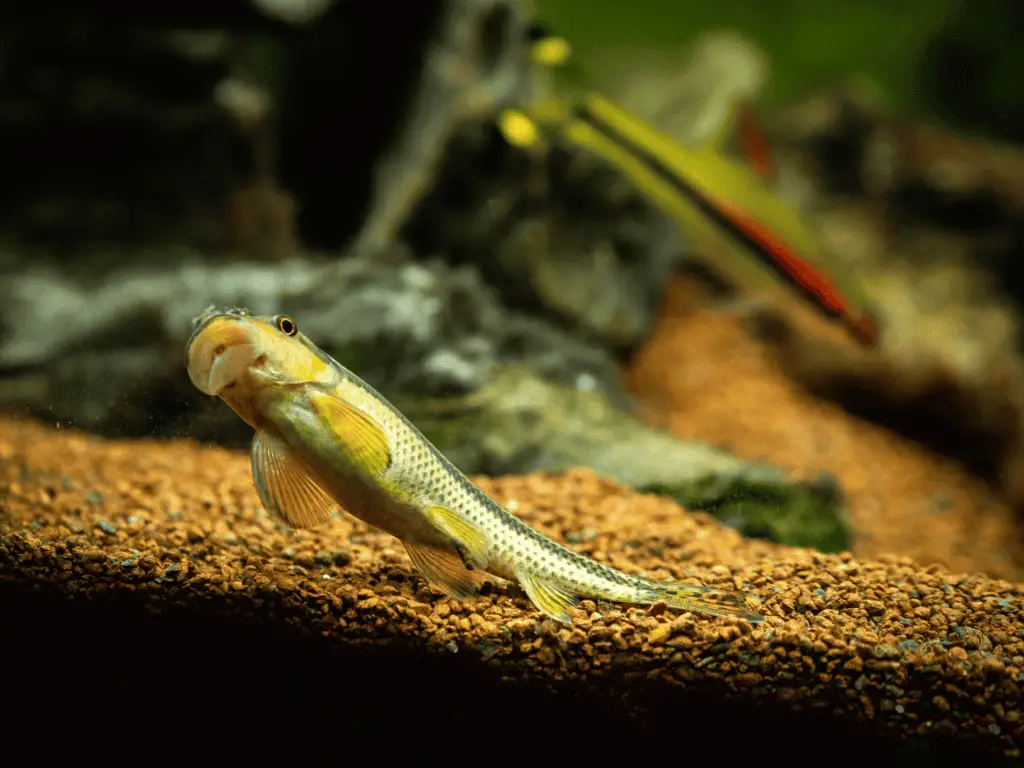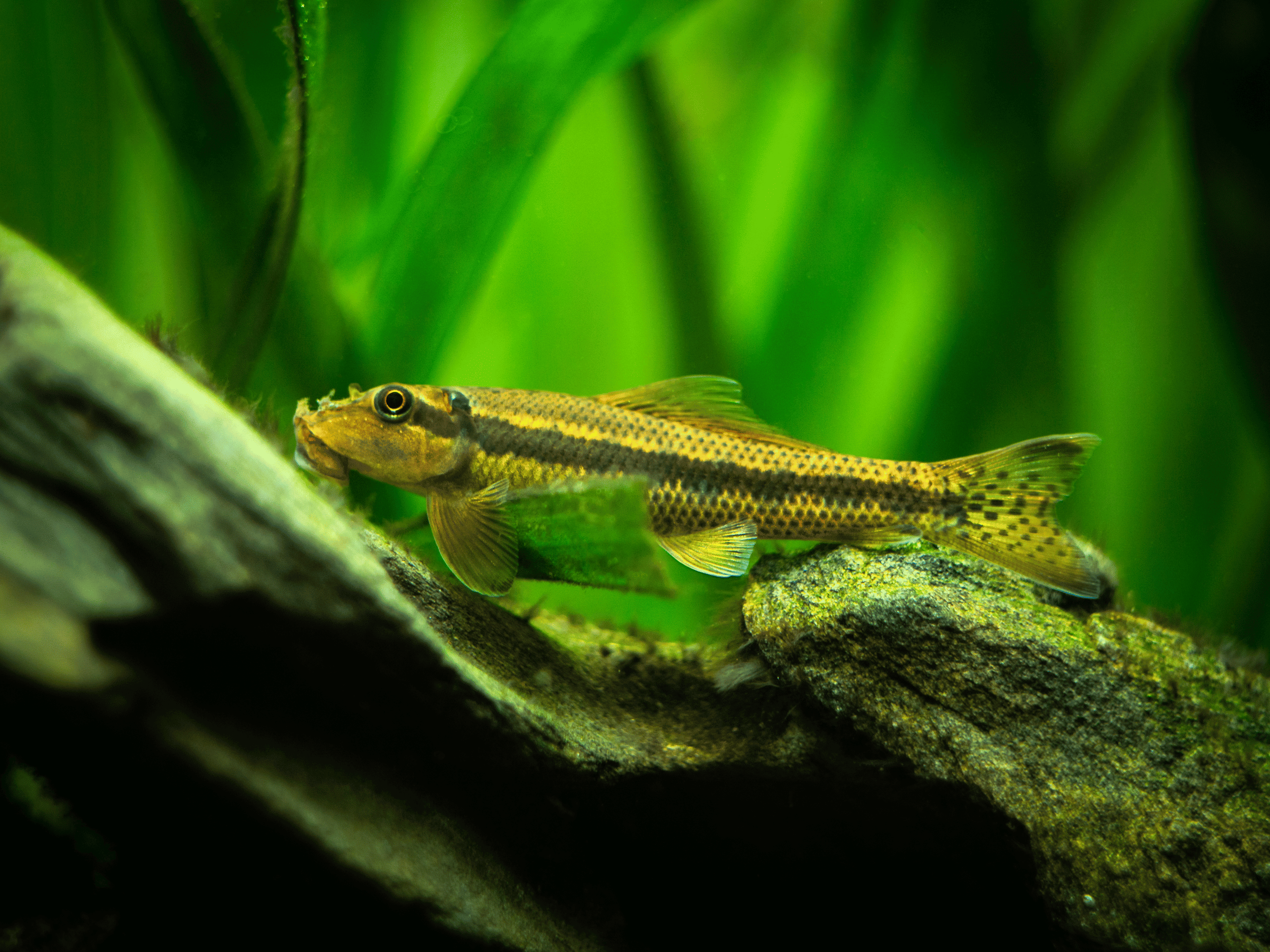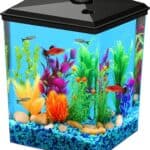Introduction
Diving into the world of the aquarium, we encounter the fascinating Gyrinocheilus aymonieri, commonly known as the Chinese Algae Eater. A prominent figure in Southeast Asia and southern China’s aquatic habitats since its discovery by Tirant in 1883, this fish holds a dual role as an aquarium star and culinary delight in its native lands. Although the IUCN Red List marks this species as of Least Concern (LC), we notice some dwindling populations, notably in Thailand, with it considered threatened in China and Viet Nam.
The Ideal Aquarium for a Chinese Algae Eater
If you’re considering introducing the Chinese Algae Eater to your aquarium, we suggest a minimum 30-gallon tank. For a stimulating environment:
- Incorporate plenty of plants, rocks, and driftwood for algae grazing.
- Ensure adequate swimming space.
Multiple Chinese Algae Eaters can share a habitat, with six being the optimal number. They thrive in mature, well-filtered planted aquariums that offer multiple hiding spots, along with shaded areas to escape bright aquarium lights.
Key considerations for your tank include:
- Strong currents with well-oxygenated water.
- Water pH between 6.5 -7.5, hardness 8 to 12° dKH, and temperature 75 – 80° F.
- Monthly water changes of 25 – 50% (or weekly 20-25% for densely stocked tanks).
- A secure hood to prevent your fish from jumping out.
Note: As the Chinese Algae Eater matures, it may display aggression towards tank mates, so it’s recommended to avoid pairing with smaller fish like Neon Tetras or slow-moving high-backed fish such as Angelfish and Discus.

The Chinese Algae Eater’s Diet
Your Chinese Algae Eater is primarily a herbivore, with a young one’s main diet being algae on plants, rocks, glass, driftwood, and other substrates. As it matures, it may develop a taste for the slime, eyeballs of larger fish, and even whole smaller fish.
While captive, this species adapts well to a meatier diet, including:
- Prepared aquarium foods.
- Frozen crustaceans and small fish.
- Sinking algae wafers, sinking catfish wafers.
- Blanched vegetables like zucchini.
Feeding once or twice daily should suffice.
Breeding Chinese Algae Eaters
Breeding Chinese Algae Eaters in captivity remains a relatively uncharted territory, although we know they are egg layers. Good water chemistry and strong water flow are the key triggers to induce spawning.
For breeding, you will need:
- A 50-gallon tank with very few plants and a strong water current.
- Suitable water temperature and pH, ranging from 77-82 0F and 6-8 respectively.
Fry usually hatches within 2-3 days and should be fed with algae and fallen food.
Distinguishing Male from Female
In the world of the Chinese Algae Eater, distinguishing males from females proves challenging. While both genders possess multiple small tubercles or thorns around their mouth, males showcase more pronounced tubercles during the spawning season. On the other hand, an adult female has a thicker, rounder body while a male’s body is thin and narrow.
Life Expectancy and Health of Chinese Algae Eaters
Chinese Algae Eaters are a relatively hearty species that, given proper care and a conducive environment, can live up to 10 years in an aquarium setting. These fish are not usually susceptible to specific diseases but maintain good water quality and a balanced diet to ensure their overall health.
Chinese Algae Eaters and Co-inhabitants
It’s important to carefully choose tank mates for your Chinese Algae Eaters. While they tend to become more aggressive as they age, they do well with certain semi-aggressive fish like African Mbuna Cichlids. Refrain from introducing them to a tank with Goldfish, as this combination is often unsuccessful.
Color and Markings of Chinese Algae Eaters
Chinese Algae Eaters sport an attractive coloration and markings, adding visual interest to your tank. They often exhibit a yellowish-brown body with a dark, longitudinal stripe. Younger individuals may possess more pronounced colors, which can fade as they grow and mature.
Handling and Care for Chinese Algae Eaters
Chinese Algae Eaters require vigilant care and attention. Since they are jumpers, a secure hood on your tank is essential to keep them contained. They are also strong swimmers, so a tank with a substantial water current suits them well. Additionally, these fish prefer their privacy, so a setup with enough hiding spots is essential.

Benefits of Chinese Algae Eaters to Your Aquarium
A key benefit of keeping Chinese Algae Eaters is their aptitude for algae consumption, which helps keep your tank clean. This capacity is particularly valuable in heavily planted tanks where manual algae removal can be a challenging task. It’s worth noting, however, that as they age, their penchant for algae diminishes and they may develop a preference for other food types.
Chinese Algae Eater: The Aquarist’s Ally
The Chinese Algae Eater stands out as a popular choice for aquarium enthusiasts, mainly due to its extraordinary ability to control algae. Its accessibility, affordability, and utility make it a cherished addition to many aquariums. When you’re ready to add these fascinating creatures to your aquatic family, several reputable online vendors can cater to your needs, ensuring that your next Chinese Algae Eater is just a click away. This charming fish not only adds a dynamic element to your underwater habitat but also helps maintain a healthy, algae-free environment.
Conclusion
In essence, the Chinese Algae Eater presents itself as an interesting, low-maintenance, and beneficial addition to your home aquarium. While its care involves certain specificities, the reward of a clean tank and the captivating sight of this active fish make it a worthwhile choice for both novice and experienced aquarists. With the right conditions and companions, your Chinese Algae Eater will thrive, contributing significantly to the biodiversity and equilibrium of your aquatic world.
Frequently Asked Questions
1. What is the scientific name of the Chinese Algae Eater?
The scientific name of the Chinese Algae Eater is Gyrinocheilus aymonieri. It belongs to the family Gyrinocheilidae under order Cypriniformes of Class Actinopterygii.
2. What is the ideal aquarium setup for a Chinese Algae Eater?
The ideal aquarium for a Chinese Algae Eater should be at least 30-gallon with plenty of plants, rocks, and driftwood for the fish to graze on for algae. The tank should have shaded areas as these fish often prefer to avoid bright aquarium lights.
3. What should I feed my Chinese Algae Eater?
The diet of a Chinese Algae Eater mainly consists of algae in their young stage. As they mature, their diet can become more varied, including the slime and eyeballs of larger fish and even whole smaller fish. In captivity, they also eat prepared aquarium foods, frozen crustaceans, small fish, sinking algae wafers, and blanched vegetables like zucchini.
4. Can I breed Chinese Algae Eaters in captivity?
Yes, but breeding Chinese Algae Eaters in captivity is not well-understood. These fish are egg layers, and good water chemistry along with strong water flow is believed to trigger spawning.
5. How can I differentiate between a male and a female Chinese Algae Eater?
Males and females both have small tubercles or thorns around their mouth, but these are more pronounced in males during the spawning season. Adult females typically have a thicker, rounder body, whereas males have a thin and narrow body.
6. How long does a Chinese Algae Eater live?
With appropriate care, Chinese Algae Eaters can live up to 10 years in an aquarium.
7. Can Chinese Algae Eaters cohabitate with other fish?
Yes, but with caution. Chinese Algae Eaters can become aggressive as they mature. They should not be kept with smaller fish such as Neon Tetras or slow-moving, high-backed fish like Angelfish and Discus. They can cohabitate well with certain semi-aggressive fish such as African Mbuna Cichlids.
8. What are the benefits of keeping a Chinese Algae Eater in my aquarium?
The most notable benefit of a Chinese Algae Eater is its ability to control algae in the tank, helping to keep your aquarium clean. However, their interest in algae decreases as they age, and they may develop a preference for other types of food.
9. Where are Chinese Algae Eaters found in the wild?
In the wild, Chinese Algae Eaters are found in large areas of Southeast Asia and southern parts of China. They are used as both aquarium and food fish in their native countries.
10. Can Chinese Algae Eaters jump out of the tank?
Yes, Chinese Algae Eaters are known to be able to jump out of the tank. Therefore, it is recommended to have a secure hood on your tank to prevent this from happening.






